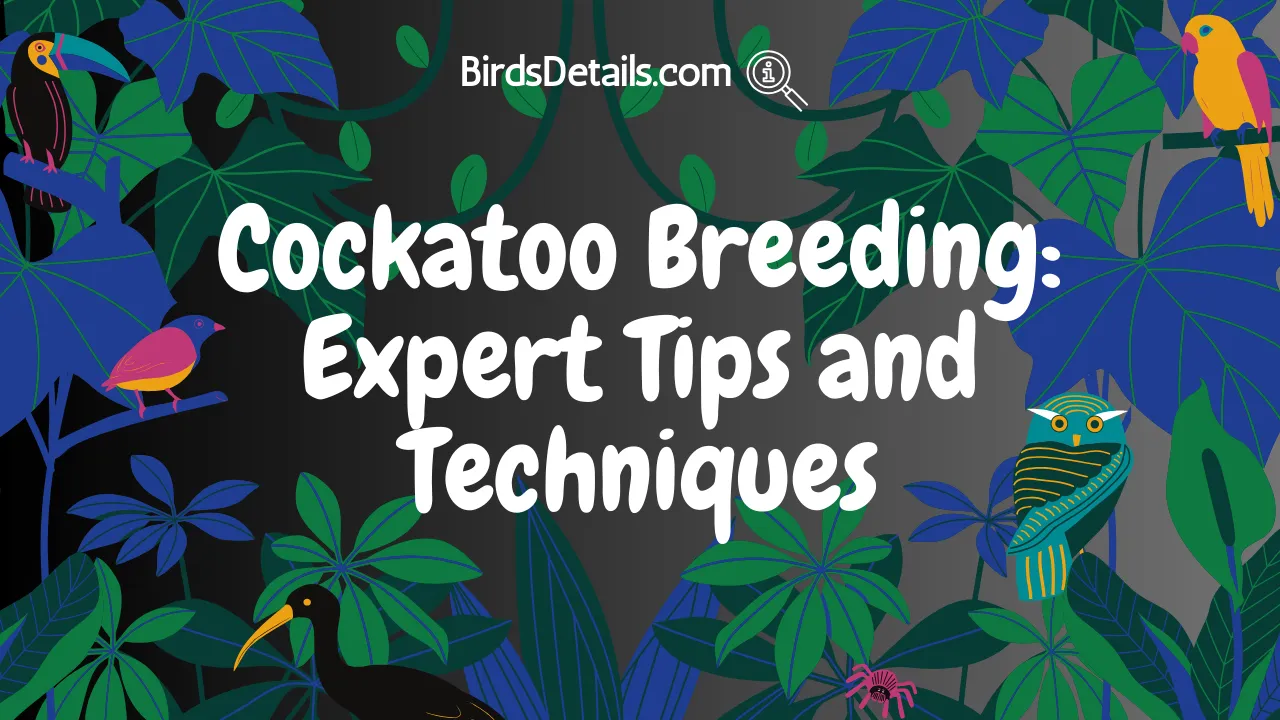Breeding cockatoos and macaws as pets may seem like a fun and exciting venture, but it’s not something you should take lightly. Before diving in, you need to understand that this is a complex process that requires extensive knowledge and preparation, especially for large clutches. Additionally, proper cage construction is crucial for the safety and well–being of these birds.
Firstly, researching the different species of cockatoos and macaws and their specific needs is crucial for pet owners. Each species has its unique requirements for breeding success and large clutches, so it’s important to know what you’re getting into before starting. Additionally, proper cage construction is essential for both cockatoos and macaws to ensure their safety and comfort.
Breeding cockatoos and macaws can be expensive due to the specialized equipment needed and providing a suitable environment for the birds. It’s not just about putting two birds together and hoping for the best – there are costs involved in ensuring their health and wellbeing. Macaws also tend to lay large clutches of eggs, which require extra care and attention. Breeding these birds can take years of experience and knowledge, as well as a high-quality diet such as Kaytee Exact, to ensure successful breeding outcomes.
To produce healthy offspring in macaws and white cockatoos, you must have a solid understanding of genetics and breeding techniques, including the identification of male birds. This includes understanding how traits are passed down from parent birds to their offspring.
It’s essential to note that breeding cockatoos and macaws should only be attempted by experienced individuals who are committed to providing proper care for the birds. Proper identification of the species is also crucial. It’s not something you should do on a whim or without careful consideration.
In short, if you’re considering breeding cockatoos and macaws, there’s a lot you need to know beforehand. In this guide, we’ll cover everything from selecting compatible pairs of birds to caring for newborn chicks. Make sure to also consider the size difference between the two species, as macaws can grow up to 40 inches in length. So let’s dive in!
Understanding the Natural Breeding Behavior of Cockatoos:

Breeding cockatoos and macaws can be a challenging task, but understanding their natural breeding behavior is crucial for successful breeding in captivity. In this section, we will discuss the unique breeding behavior of cockatoos and how it is influenced by their instincts, as well as how this applies to breeding macaws.
Male Cockatoos:
During the breeding season, male cockatoos and macaws can display aggressive behavior towards their mates or potential mates. This aggression is a normal part of their mating rituals and should not be cause for concern. It is important to note that this behavior may also occur outside of the breeding season, especially if there are hormonal imbalances or stress factors present.
Mating Rituals:
Similar to macaws and other parrots, cockatoos have specific mating rituals and behaviors that are important to understand to successfully breed them in captivity as breeding birds. These rituals include courtship displays such as head-bobbing, wing-flapping, and vocalizations. It is also common for males to offer food or toys to females as a sign of affection during the breeding process.
Nature vs Nurture:
It is important to understand the nature of white cockatoo behavior when attempting to breed them in captivity. Factors such as diet, socialization, and environmental enrichment play an essential role in creating a safe and comfortable environment for your birds during the breeding process. The same goes for macaws.
Providing your macaws with a balanced diet that includes fresh fruits and vegetables can help regulate hormones and reduce stress levels. Socialization is also crucial for developing strong bonds between macaw mates and reducing aggressive behavior during the breeding process.
Environmental enrichment can also play an important role in reducing stress levels among captive birds, including macaws. Providing your macaws with toys, perches, and other forms of stimulation can help mimic their natural habitat and promote healthy behaviors.
Frequently Asked Questions:
What Is Cockatoo and Macaw Breeding Behavior? Cockatoo breeding behavior refers to the unique behaviors and rituals that cockatoos display during the breeding season, including courtship displays, vocalizations, and aggressive behavior. Macaws also have their own unique breeding behavior patterns.
Where Do Cockatoos Poop? Cockatoos typically poop on perches or other elevated surfaces within their enclosure. It is important to provide your birds with a clean and hygienic environment to prevent the spread of disease.
Why Do Cockatoos Scream? Cockatoos may scream for a variety of reasons, including boredom, attention-seeking behavior, or stress. Providing your birds with environmental enrichment and socialization can help reduce excessive screaming behavior.
Tips for Successful Cockatoo Breeding in Captivity:
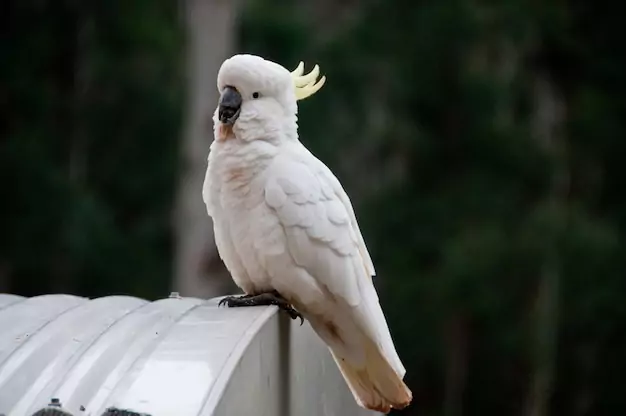
Breeding cockatoos is a rewarding experience, but it requires careful planning and preparation. Here are some tips to help you successfully breed your cockatoos in captivity.
Provide a Spacious and Secure Enclosure
Cockatoos need plenty of space to move around and exercise. A spacious enclosure will also allow the breeding pair to establish their territories and reduce stress levels. The enclosure should be secure, with no gaps or holes that could allow predators to enter.
Offer a Balanced Diet
A balanced diet is essential for the health of your breeding pair and their offspring. Fresh fruits, vegetables, and high-quality pellets should make up the majority of their diet. You can also offer small amounts of seeds as treats.
Mimic Natural Breeding Conditions
To encourage your cockatoos to breed, you need to create an environment that mimics their natural habitat. This includes providing a nesting box where they can lay their eggs and incubate them. You should also monitor the temperature and humidity levels to ensure they are optimal for breeding.
Observe Behavior Closely
Breeding pairs of cockatoos may display aggressive behavior towards each other or humans during breeding season. It’s important to observe their behavior closely so you can intervene if necessary. Health issues such as egg-binding or infections can also arise during the breeding season, so regular check-ups by a veterinarian are recommended.
Breeding cockatoos is not an easy task, but with proper care and attention, it can be a rewarding experience for both you and your birds.
If you’re wondering how to breed cockatoos successfully, follow these tips for the best results. And don’t forget about what cockatoo birds eat – a balanced diet is key!
Techniques for Successful Cockatoo Breeding in Captivity:

Breeding cockatoos can be a rewarding experience, but it requires proper care and attention to ensure successful breeding. In captivity, it is important to create an environment that mimics the natural habitat of these birds. Here are some techniques for successful cockatoo breeding in captivity.
Proper Cage Construction
The first step in successful cockatoo breeding is to provide a suitable cage. The cage should be large enough to allow the birds to move around freely and have plenty of space for nesting boxes. The bars on the cage should also be spaced close enough together to prevent any escape attempts.
When constructing a cage, it is important to use materials that are safe for the birds. Avoid using materials that contain lead or zinc as they can be toxic to cockatoos. Stainless steel or powder-coated cages are good options as they are durable and easy to clean.
Spacious and Stimulating Environment
Cockatoos, especially breeding birds, can become stressed when kept in captivity, so it is important to provide them with a spacious and stimulating environment. This includes providing plenty of toys, perches, and other items that will keep them entertained.
It is also important to allow the birds time outside of their cages each day. This will allow them to stretch their wings and exercise.
Regular Cleaning
Keeping the cage clean is crucial for maintaining a healthy breeding environment. Cockatoos can be susceptible to disease, so it is important to clean their cages regularly. This includes removing any droppings or uneaten food daily and disinfecting the cage at least once a week.
Nesting Materials
Providing nesting materials and boxes in the cage is essential for encouraging breeding behavior in cockatoos. These materials should include soft bedding such as shredded paper or pine shavings.
Nesting boxes should also be provided within the cage. These boxes should be large enough to accommodate the birds and should be placed in a location that is easily accessible.
Breeding Behavior
Cockatoos typically mate for life, so it is important to pair them with a compatible partner. It is also important to ensure that both birds are healthy before breeding.
Breeding behavior can be encouraged by providing nesting materials and boxes, as well as creating a suitable environment. Cockatoos will typically mate in private, so it is important to provide them with a secluded area within their cage.
Specific Information on Breeding Umbrella Cockatoos:
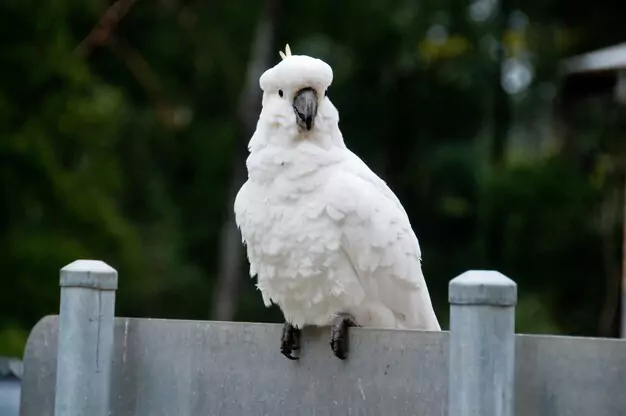
Breeding umbrella cockatoos is not for the faint of heart. These beautiful birds require a lot of patience, dedication, and knowledge about their specific needs. If you’re an experienced breeder looking to take on the challenge of breeding umbrella cockatoos, here are some important things to keep in mind.
Popular Species for Breeding
Umbrella cockatoos are one of the most popular white cockatoo species for breeding. They have a striking appearance with their white feathers and bright yellow crests. They are also known for their playful personalities and ability to mimic human speech.
Complex Behavior
Breeding umbrella cockatoos can be challenging due to their complex behavior. These birds require a lot of attention and socialization from a young age to develop healthy relationships with humans. It’s important to establish trust and respect with your birds before attempting to breed them.
Spacious Enclosure
During the breeding season, it’s crucial to provide your umbrella cockatoos with a spacious enclosure that allows them plenty of room to move around and mate. The enclosure should be equipped with nesting boxes, perches, and toys to keep the birds stimulated.
High-Quality Diet
Feeding your umbrella cockatoos a high-quality diet is essential for improving their reproductive success. Kaytee Exact is a popular brand among bird breeders due to its balanced nutrition and easy digestibility.
Experienced Breeders Only
Breeding umbrella cockatoos should only be done by experienced breeders who know their specific needs. These birds require specialized care during breeding season, including monitoring for signs of illness or aggression.
Monitor Breeding Process
Monitoring the breeding process of your umbrella cockatoos is crucial for ensuring the health and safety of both the parents and offspring. You should observe the birds closely during mating, egg-laying, incubation, and hatching to ensure that everything is progressing normally.
Choosing the Right Pair for Breeding:
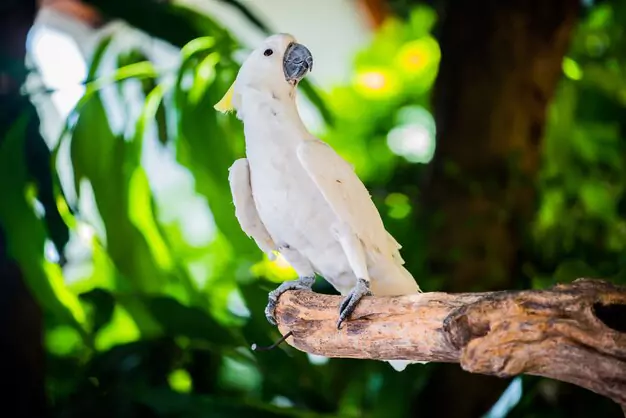
Breeding cockatoos can be a rewarding experience, but choosing the right breeding pair is crucial for success. Here are some important factors to consider when selecting a pair.
Size and Species
When choosing a breeding pair, it’s important to consider the size and species of the birds. Cockatoos come in different sizes and colors, so breeders should choose pairs that are compatible in terms of size and species. This will increase the chances of successful breeding and reduce the risk of aggression between mates.
Health and Condition
Males should be healthy and in good condition to ensure successful breeding. Breeders should inspect potential males for any signs of illness or injury before choosing them as breeding partners. It’s also important to ensure that both birds are free from any genetic defects or diseases that may affect their offspring.
Bond Between Pairs
A strong bond between the pair is important for successful breeding. Cockatoos are social animals and tend to form strong bonds with their mates. Breeders should observe potential pairs to see if they show signs of bonding such as preening each other or sharing food.
Eye Color
Eye color can indicate the sex of the bird, which is important when choosing a mate. In most cockatoo species, males have dark brown or black eyes while females have lighter-colored eyes such as brownish-red or pinkish-brown. However, this method may not be accurate for all species, so it’s best to consult with an expert.
Diet
A balanced diet that includes seeds and a breeding formula can increase the chances of successful breeding during the breeding season. Breeders should provide their birds with high-quality food rich in protein, vitamins, and minerals essential for reproduction.
Creating a Suitable Environment for Cockatoo Breeding:
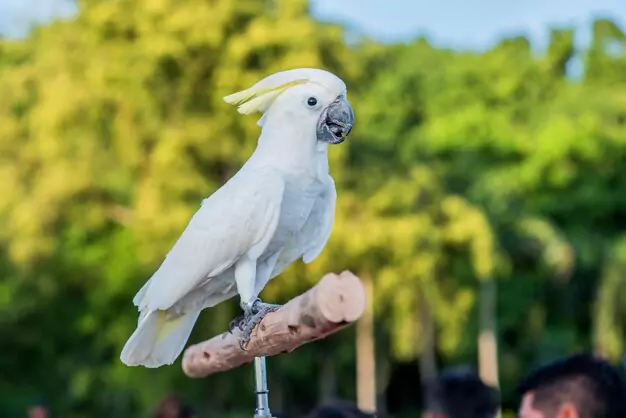
Breeding cockatoos can be a rewarding experience, but it requires providing them with a suitable environment. In this article, we’ll discuss the key elements of creating an ideal environment for cockatoo breeding.
The Bird Aviary
A bird aviary is an ideal environment for cockatoo breeding. It provides ample space for the birds to move around and fly, which is essential for their physical and mental health. The aviary should be large enough to accommodate the birds and their nest box comfortably. A good rule of thumb is to have at least 10 square feet of floor space per pair of birds.
Nest Boxes
Nest boxes made of wooden boxes are recommended for cockatoo breeding. These provide a warm and secure place for the birds to lay their eggs and raise their young. The size of the nest box should be appropriate for the size of your cockatoos.
Floor Covering
The floor of the aviary should be covered with suitable materials to keep it dry and clean. You can use newspaper or paper towels as a temporary solution, but these will need to be changed regularly. A better option is to use pine shavings or wood chips, which absorb moisture and help control odor.
Temperature Control
Cockatoos are sensitive to temperature changes, so it’s important to maintain a consistent temperature in their environment. Ideally, the temperature should range between 70-80 degrees Fahrenheit throughout the day.
Lighting
Lighting plays an important role in regulating a bird’s reproductive cycle. Providing 12-14 hours of light each day can stimulate breeding behavior in your cockatoos.
Diet
A healthy diet is crucial for successful breeding in cockatoos. Make sure that they have access to fresh water at all times and provide them with a variety of fruits, vegetables, seeds, nuts, and pellets.
Importance of Proper Nutrition for Successful Breeding:

Proper nutrition is essential for successful breeding in cockatoos. Breeding birds require a well-balanced diet that includes a variety of foods such as nuts and fruits to ensure their health and fertility. Consultation with a veterinarian can help determine the best diet for your cockatoos.
Overfeeding or Underfeeding Can Negatively Impact Breeding Success
It is important to provide a consistent and appropriate diet throughout the breeding season to increase the chances of successful breeding. Overfeeding or underfeeding can negatively impact breeding success, leading to health problems and decreased fertility in cockatoos.
Nutritional Deficiencies Can Lead to Health Problems
Nutritional deficiencies can lead to various health problems in cockatoos, including feather plucking, egg binding, and poor chick development. Therefore, it is crucial to ensure that your birds receive adequate nutrition through their diet.
A Balanced Diet Is Essential
A balanced diet should consist of fresh fruits, vegetables, grains, nuts, and seeds. Cockatoos also require protein from sources such as cooked eggs or lean meats like chicken or turkey. It is important to avoid feeding them processed foods high in sugar or salt.
The Role of Veterinarians
Consulting with a veterinarian who specializes in avian medicine can help determine the appropriate diet for your birds. They can also guide vitamin and mineral supplements if necessary.
Consistency Is Key
Consistency is key. Providing them with a consistent source of food will help regulate their hormone levels and increase their chances of successful reproduction.
Monitoring Egg-Laying and Incubation Process:

Breeding cockatoos can be a rewarding experience, but it requires careful monitoring of the egg-laying and incubation process. Here are some important points to keep in mind when breeding cockatoos:
Monitor egg-laying to ensure healthy breeding
Cockatoo females typically lay one to two eggs at a time, with a total clutch size of up to four eggs. It’s essential to monitor the female’s behavior closely during this time, as any signs of distress or discomfort could indicate health problems that may affect the breeding process.
The incubation process takes about a month
Once the eggs have been laid, they need to be incubated for approximately 28-30 days before hatching. During this time, it’s crucial to maintain a stable temperature and humidity level in the incubator or nesting box.
Eggs can be identified through candling
Candling is a technique used to identify fertile eggs by shining a bright light through them. This method allows breeders to check whether an egg has been fertilized and monitor its development throughout the incubation period.
Cockatoos have a lifespan of up to 70 years
Breeding cockatoos is not just about producing healthy chicks; it also involves ensuring their long-term welfare. Cockatoos are long-lived birds that can live up to 70 years in captivity, so it’s essential to provide them with proper care throughout their lives.
Breeding pairs can produce eggs for several years
If breeding pairs are well cared for, they can continue producing fertile eggs for several years. However, it’s crucial not to overbreed birds, as this can lead to health problems and reduced fertility rates over time.
Timely monitoring is crucial for successful hatching
Successful cockatoo breeding requires careful attention and timely intervention when necessary. If there are any signs of problems during the egg-laying or incubation process, it’s essential to act quickly and seek veterinary advice if necessary.
Hand-Rearing Chicks if Necessary:

Breeding cockatoos can be an exciting and rewarding experience, but it also comes with its challenges. One of these challenges is the possibility that the female may neglect her clutch, leaving you with the responsibility of hand-rearing any chicks. Here are some important things to keep in mind when hand-rearing cockatoo chicks:
Feeding Schedule
Young chicks need to be fed every 2-3 hours during the day. This means that you will need to be available to feed them frequently throughout the day. It’s important to establish a feeding schedule and stick to it as closely as possible.
Hygiene
Hand-rearing requires careful attention to hygiene. Make sure that all equipment used for feeding and cleaning is thoroughly cleaned and sanitized before each use. Any leftover formula should be discarded after each feeding.
Heat Source
Chicks should be kept warm with a heat source such as a heat lamp or heated barrels. The ideal temperature for young chicks is around 95-100 degrees Fahrenheit. As chicks grow, they will require less heat, so it’s important to monitor their behavior and adjust the temperature accordingly.
Toys and Vegetables
As chicks grow, they will need toys and vegetables to encourage healthy development. Providing toys helps stimulate their minds while vegetables provide essential nutrients for growth.
Age at Removal from Nest
Chicks should not be removed from the nest until they are at least 4 weeks old and have strong legs and feet. At this age, they will also have developed enough feathers to regulate their body temperature without relying on a heat source.
Screaming Behavior
It’s important to note that hand-reared cockatoos may develop screaming behavior due to being raised by humans instead of their parents. This behavior can be difficult to manage, so it’s important to consider whether or not you are prepared for this possibility before deciding to hand-rear chicks.
Hand-rearing cockatoo chicks can be a challenging but rewarding experience. With careful attention to feeding schedules, hygiene, and providing the necessary heat source and toys, you can help ensure that your chicks grow up healthy and strong.
Potential Challenges in Cockatoo Breeding:

Breeding cockatoos is not an easy task, and it comes with its own set of challenges. In this section, we will discuss some potential issues that breeders may face during the cockatoo breeding process.
Parrot Fever
One of the potential problems that can arise during cockatoo breeding is parrot fever. This disease is caused by a bacterium called Chlamydia psittaci, which can be transmitted from infected birds to humans. Symptoms of parrot fever include fever, headache, muscle aches, and respiratory symptoms. To prevent parrot fever from spreading among birds and humans, it’s essential to maintain proper hygiene and cleanliness in the breeding environment.
Health Issues During Breeding
Cockatoos are susceptible to various health issues during breeding, such as egg binding (when eggs get stuck inside the female bird), calcium deficiency (which can lead to soft-shelled eggs), and infections. Breeders must monitor their birds’ health closely and provide them with a balanced diet rich in calcium to prevent these issues.
Crest Difficulties
The crest of some cockatoo species can cause difficulties during breeding. For example, Moluccan cockatoos have large crests that can obstruct their vision during mating. This can make it challenging for the male bird to find the female’s cloaca (reproductive opening). Breeders may need to trim or style the crest hair to avoid this problem.
Aggression
Breeding cockatoos can be challenging due to their high level of aggression. Male birds can become territorial and aggressive towards other males or even females if they feel threatened or stressed. Breeders must keep pairs separated until they are ready for mating and ensure enough space for each pair.
Inexperience
Inexperienced breeders may face challenges. It takes time, effort, and knowledge to breed healthy birds successfully. Breeders must research and learn about the breeding process, including incubation, hatching, hand-feeding, and weaning before attempting to breed their birds.
Key Takeaways for Successful Cockatoo Breeding
Breeding cockatoos can be a challenging but rewarding experience. To ensure successful breeding, it is important to understand the natural breeding behavior of cockatoos and follow these tips and techniques:
Understanding the Natural Breeding Behavior of Cockatoos: Before attempting to breed your cockatoos, it is essential to learn about their natural breeding behavior. This includes their mating rituals, nesting habits, and incubation period.
Tips for Successful Cockatoo Breeding in Captivity: When breeding cockatoos in captivity, there are several things you can do to increase your chances of success. These include providing proper nutrition, creating a suitable environment for breeding, and monitoring egg-laying and incubation closely.
Techniques for Successful Cockatoo Breeding in Captivity: In addition to the following basic tips, there are specific techniques you can use to encourage successful breeding. For example, providing a nest box with suitable dimensions and materials can help stimulate nesting behavior.
Specific Information on Breeding Umbrella Cockatoos: If you plan on breeding umbrella cockatoos specifically, it is important to know that they have unique needs compared to other species of cockatoo. Researching their specific requirements will increase your chances of success.
Choosing the Right Pair for Breeding: Choosing the right pair of birds is crucial. Factors such as age, health status, and compatibility should all be taken into consideration.
Creating a Suitable Environment for Cockatoo Breeding: Providing an environment that mimics the natural habitat of your birds is key. This includes factors such as temperature control and lighting conditions.
Importance of Proper Nutrition for Successful Breeding: Proper nutrition is essential. Providing a balanced diet rich in vitamins and minerals will help ensure your birds are healthy and able to produce healthy offspring.
Monitoring Egg-Laying and Incubation Process: Monitoring the egg-laying and incubation process closely is important to catch any potential issues early on. This includes monitoring for signs of infertility or disease.
Hand-Rearing Chicks if Necessary: In some cases, it may be necessary to hand-rear chicks if the parents are unable to care for them properly. Knowing how to do this safely and effectively is crucial.
Potential Challenges in Cockatoo Breeding: Despite your best efforts, there may still be challenges. These can include issues such as egg-binding, infertility, or aggression between pairs.
Overall, successful cockatoo breeding requires a combination of knowledge, preparation, and patience. By following these tips and techniques, you can increase your chances of success and enjoy the rewards of raising healthy baby birds.
